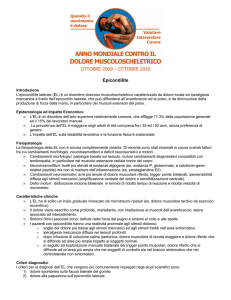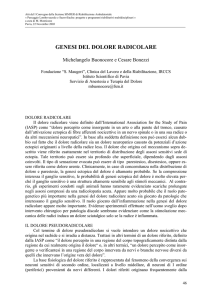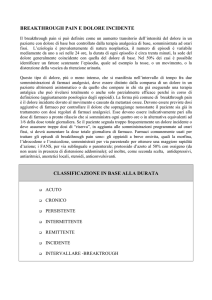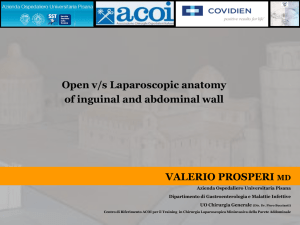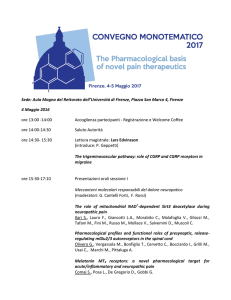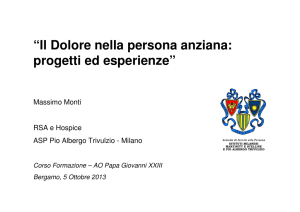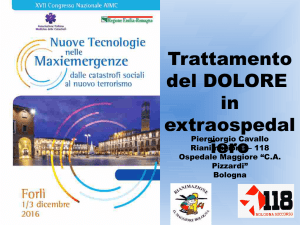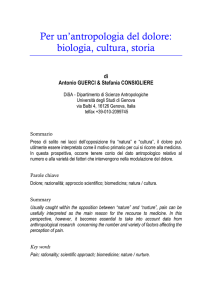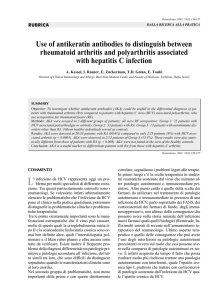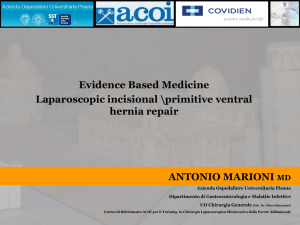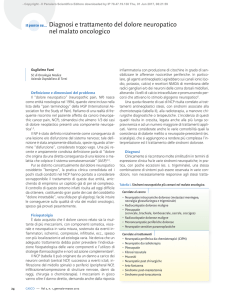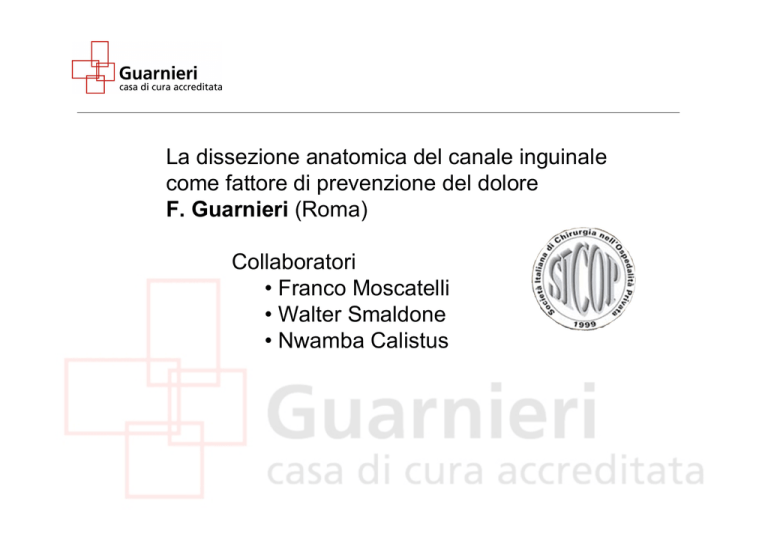
La dissezione anatomica del canale inguinale
come fattore di prevenzione del dolore
F. Guarnieri (Roma)
Collaboratori
• Franco Moscatelli
• Walter Smaldone
• Nwamba Calistus
DEFINIZIONE DI DOLORE
Il dolore e’ un esperienza sensoriale ed emozionale spiacevole
associata ad un pericolo tessutale presente o potenziale, o descritto
in termini di potenziale danno.
International Association for the Study of the Pain – IASP 1979
Cause Chimiche
Cause Meccaniche
° infiammazione
° variazioni di PH
° ischemia
° necrosi
° spasmo della muscolatura liscia
° distensione della capsula di organi parenchimatosi
° infiltrazione o compressione di tronchi nervosi
° distensione della parete di visceri
° trazione di legamenti o mesi
Cause Fisiche
° Caldo
° Freddo
COMPONENTI DEL DOLORE
Componente Emozionale
Componente Fisiopatologica
Viscerale
•Distensione, stiramento degli organi ricoperti da peritoneo;
•Infiammazione degli organi e del peritoneo che li avvolge;
•Infiammazione per fatti ischemici (es. ansa intestinale non irrorata
e dunque in ischemia)
•Spasmo delle pareti degli organi cavi
Parietale
• Superficiale (cutaneo)
• Profondo (muscolare o fasciale)
Riferito
• Proviene da altre localizzazioni (es. Ernia Discale con dolore
inguinale)
ANATOMIA DEL CANALE INGUINALE
• Nervo grande addomino-genitale (Nervus [N] iliohypogastricus)
Origina da L1 tra i due fasci dello psoas, emerge a livello del margine laterale dello psoas all'altezza del disco L1-L2
e si dirige in basso e lateralmente incrociando la faccia anteriore del quadrato dei lombi. Perfora il muscolo
trasverso a 3-4 cm dal margine laterale del quadrato dei lombi; da origine ad un ramo a destinazione glutea e si
divide in due rami. II ramo addominale decorre tra il muscolo trasverso e il piccolo obliquo e scambia anastomosi
con gli ultimi nervi interecostali. II ramo genitale perfora il piccolo obliquo nei pressi della spina iliaca anterosuperiore e decorre sulla faccia profonda del piccolo obliquo, parallelo al funicolo e molto a ridosso di quest'ultimo.
Esso abbandona il canale inguinale a livello dell'orifizio inguinale superficiale e distribuisce i suoi rami terminali alla
cute della regione crurale, del pube e dello scroto.
• Nervo piccolo addomino-genitale (N. ilioinguinalis)
E’ assente nel 25% dei casi W. Segue un percorso parallelo al
precedente, un poco al disotto di esso. I due nervi sono
ampiamente anastomizzati e le loro terminazioni genitali sono
spesso fuse in un solo ramo.
• Nervo genitocrurale (N genitofemoralis)
Origina da L2, attraversa lo psoas ed emerge da questo muscolo all'altezza
di L3-L4 . Discende obliquo in basso e all'esterno sotto la fascia iliaca.
Incrocia il decorso dei vasi spermatici e dell'uretere, costeggia la faccia
laterale dell'arteria iliaca esterna e si divide in due rami. II ramo crurale
accompagna l’arteria iliaco-femorale e si distribuisce ai tegumenti del
triangolo di Scarpa. II ramo genitale segue i vasi spermatici, attraversa
1'orifizio inguinale profondo e segue il margine inferiore del funicolo; innerva
il cremastere e si distribuisce poi ai tegumenti dello scroto.
ANATOMIA DEL CANALE INGUINALE
Via d'accesso anteriore.
1. Piccolo obliquo; 2.
trasver-so; 3. aponeurosi
del grande obliquo; 4.
ramo genitale del genitocrurale; 5. banderella
iliaco-pubica; 6. arcata
crura-le; 7. ramo
genitale del grand;
addomino-genitale.
1 Grande addomino-genitale;
2 genito-crurale; 3. femorocutaneo; 4. ramo genitale del
genito-crurale', 5. ramo crurale
del genito-crurale.
LA TECNICA DI GUARNIERI
La recidiva non e’ piu’ un problema …..
Esistono le protesi ……
La Qualita’ e il Confort fanno la
differenza ……
Abbiamo operato piu’ di 5700 pazienti dal dicembre 88 con una
tecnica il cui principio e’ modificare l’anatomia del canale inguinale
patologico rispettando la fisiologia. La protesi viene utilizzata in circa
il 20 % dei pazienti. Il 70 % dei pazienti viene dimesso lo stesso
giorno. IL 20 % il giorno successivo e il restante 10 % rimangono piu’
di un giorno. La percentuale di recidive e’ lo 0,5 %.
E’ il paziente che decide quando uscire (su indicazione del medico)
TECNICA DI GUARNIERI
LA TECNICA CHIRURGICA
• Incisione chirurgica
• Rispetto dell’anatomia e della fisiologia
• Isolamento dei tessuti
• Coagulazione (necrosi tessutale)
• Suture
• Uso della protesi
• Trattamento sacco erniario
• Durata dell’intervento
• Prevenzione delle complicanze infettive
INCISIONE CHIRURGICA
ORIZZONTALE E BREVE
• Decorso dei nervi
• Cicatrice piu’ morbida
• Minori dissezioni e scollamenti
IL RISPETTO DELL’ANATOMIA E FISIOLOGIA
Evitare di defunzionalizzare e
immobilizzare muscoli del canale
inguinale
Rispettare i piani muscoloaponeurotici
Evitare la protesi
Rispettare le strutture nervose
Evitare scollamenti ed eccessive
dissezioni
USO DELLA PROTESI
Meglio non usare la protesi e’ un corpo
estraneo
Se si deve usare la protesi, la
collocazione migliore e’ il properitoneo
Ned Tijdschr Geneeskd. 2008 Oct 11;152(41):2205-9
de Lange DH, Wijsmuller AR, Aufenacker TJ, Rauwerda JA, Simons MP.
VU Medisch Centrum, afd. Heelkunde, Amsterdam.
Two male patients, aged 37 and 56, suffered from neuralgic pain after a Lichtenstein procedure for
inguinal hernia repair using prosthetic reinforcement. Since mesh-based repair techniques have
decreased the recurrence rate, postoperative inguinal pain has become a major complication of
these operations. Three months after surgery, 20% of the patients experience some pain. In 12% of
the patients this pain limits daily activities and 1-3% of the patients are invalidated by neuralgic pain.
Preventing damage to sensory nerves during the operation is one way of preventing neuralgic pain.
Damaged sensory nerves should be excised. Neuralgic pain after the operation may be alleviated by
tricyclic antidepressants, opioids or antiepileptic drugs. In selected patients with neuralgic pain
neurectomy is indicated. In one of the patients presented the neuralgic pain disappeared after
neurectomy of the ilioinguinal nerve. Triple neurectomy in the other patient, however, was
unsuccessful.
PMID: 19009804 [PubMed - indexed for MEDLINE]
TRATTAMENTO SACCO ERNIARIO
Meglio non aprirlo e non suturarlo
se non si sospettano lesioni
viscerali e se il sacco non e’
voluminoso
La resezione del sacco e’ utile per
Evitare l’irritazione
peritoneale
prevenire l’orchite ischemica nelle
ernie scrotali
Hernia. 2007 Oct;11(5):425-8. Epub 2007 Jun 27
The role of hernia sac ligation in postoperative pain in patients with elective tension-free indirect inguinal hernia repair: a prospective randomized study.
Delikoukos S, Lavant L, Hlias G, Palogos K, Gikas D.
Department of Surgery, Larissa University Hospital, 9 Papakiriazi Str, Larissa 41 223, Greece. [email protected]
BACKGROUND: Tension-free inguinal hernia repair is one of the so-called painless operations. Mild or medium postoperative pain, however, even in the mesh repair era, is common and
usually due to ilioinguinal nerve entrapment or mesh fixation in the periostium of the pubic tubercle. Especially in indirect inguinal hernia repair, however, hernia sac ligation and excision
may be the cause of pain. The aim of this study was to conduct a single-center prospective randomized trial with a view to clarify this issue on a scientific basis. METHODS: In an 8-year
period, all patients undergoing elective indirect inguinal hernia repair using a tension-free polypropylene mesh technique were randomized to induce high hernia sac ligation or not in a
double blind manner. The main endpoint was to detect any difference in postoperative pain between the two groups. RESULTS: Between January 1999 and December 2006, 477
patients with indirect inguinal hernia entered the study and were randomized to have high hernia sac ligation and excision (group A, n = 238) or not (group B, n = 239). The two groups
were comparable regarding demographic data. Postoperative pain was associated with statistically significantly more episodes in group 1, 27% (65/238), than in group 2, 10% (24/239),
on day 1, 9% (22/238), compared to 3% (8/239) on day 7, 2% (5/238), compared to 0% (0/239), on day 30, respectively, and these results were statistically significant (P <or= 0.05). All
patients were treated conservatively. CONCLUSION: From the results of this study, it appears that we are able to demonstrate a significant benefit from the omission of high hernia sac
ligation and excision on postoperative pain in patients who undergo tension-free indirect inguinal hernia mesh repair.
TECNICA DELLE SUTURE
Una sutura a triplice strato (come nella Bassini)
e’ immobilizzante e ischemizzante
Minore e’ la reazione flogistica
generata dalla sutura minore e’ il
trauma
Una sutura continua e’ meglio di
quella a punti staccati
DOLORE NEVRALGICO CRONICO
Am J Surg. 2008 Jun;195(6):735-40. Epub 2008 Apr 28
Ilioinguinal nerve excision in open mesh repair of inguinal hernia--results of a randomized clinical trial: simple solution for a
difficult problem?
Malekpour F, Mirhashemi SH, Hajinasrolah E, Salehi N, Khoshkar A, Kolahi AA.
Department of General Surgery, Loghman Medical Center, Tehran, Iran. [email protected]
BACKGROUND: Inguinodynia is the second most common complication occurring after inguinal hernia repair. This study was
undertaken to evaluate the effect of ilioinguinal nerve excision, a concept previously proposed to be performed during open hernia mesh
repair, on postsurgical pain and hyposthesia. METHODS: A double-blind randomized clinical trial was performed on 121 patients
undergoing open anterior mesh repair of inguinal hernia in 1 center from April 2005 through June 2006. The ilioinguinal nerve was
excised in half of the patients and preserved in the other half. Pain and hyposthesia at POD 1, 1 and 6 months after surgery, and 1 year
after surgery was evaluated in both groups using a visual analog scale. Results were compared using chi-square analysis. RESULTS:
Of the total number of 121 patients who entered the study, with an age range of 18 to 86 years (mean +/- SD 45 +/- 18), 115 (95%)
were male. Sixty-one were in the nerve-excision group, and 60 were in the nerve-preservation group. One hundred patients were
followed-up until the end of the first year. Using the visual analog scale to detect pain severity on postsurgical day 1, mean scores in the
nerve-excision and nerve-preservation groups were 2.2 +/- .8 (range 1 to 4) versus 2.8 +/- .7 (range 2 to 4.5), respectively (P < .001). At
1 month after surgery, these scores were .7 +/- .7 (range 0 to 3) versus 1.5 +/- .7 (range 0 to 3.5), respectively (P < .001). Between 6
months and 1 year after surgery, median scores of zero were detected in both groups. After postsurgical day 1, the median score of
hyposthesia was near zero in both groups. Thirteen patients developed chronic inguinodynia (13%), 10 of whom were in the nervepreservation group. Chronic postsurgical inguinodynia was seen in 6% of patients in the ilioinguinal nerve-excision and 21% of the
patients in the ilioinguinal nerve-preservation group (P = .033). COMMENTS: Neurectomy decreases postsurgical pain after elective
inguinal hernia repair. Although chronic inguinodynia was less frequent in our study than reported by many previous studies, it is still
wise to recommend ilioinguinal neurectomy in patients undergoing anterior inguinal hernia mesh repair.
PMID: 18440489 [PubMed - indexed for MEDLINE]
CONCLUSIONI
ERNIA INGUINALE
La recidiva non e’ piu’ un problema …..
Esistono le protesi ……
IL DOLORE INVECE
SI
FRANCESCO GUARNIERI
GRAZIE PER L’ATTENZIONE

